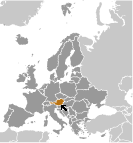World Atlas: Austria. On this page you can see the map, country flag and many detailed information about the people, history and economy of Austria.

Here you can find online selected information about the geography, inhabitants, government, economy and history of Austria. Included are selected statistics, an overview map and the detailed map of Austria. But let's start with the flag of Austria here:
Austria - Overview:
What you should know about Austria? Let's start with this: Once the center of power for the large Austro-Hungarian Empire, Austria was reduced to a small republic after its defeat in World War I. Following annexation by Nazi Germany in 1938 and subsequent occupation by the victorious Allies in 1945, Austria's status remained unclear for a decade. A State Treaty signed in 1955 ended the occupation, recognized Austria's independence, and forbade unification with Germany. A constitutional law that same year declared the country's "perpetual neutrality" as a condition for Soviet military withdrawal. The Soviet Union's collapse in 1991 and Austria's entry into the EU in 1995 have altered the meaning of this neutrality. A prosperous, democratic country, Austria entered the EU Economic and Monetary Union in 1999.
Geography of Austria
 Where on the globe is Austria? The location of this country is Central Europe, north of Italy and Slovenia. Total area of Austria is 83,871 sq km, of which 82,445 sq km is land. So this is not a large country. How could we describe the terrain of the country? This way: mostly mountains (Alps) in the west and south; mostly flat or gently sloping along the eastern and northern margins. The lowest point of Austria is Neusiedler See 115 m, the highest point Grossglockner 3,798 m. And the climate is temperate; continental, cloudy; cold winters with frequent rain and some snow in lowlands and snow in mountains; moderate summers with occasional showers.
Where on the globe is Austria? The location of this country is Central Europe, north of Italy and Slovenia. Total area of Austria is 83,871 sq km, of which 82,445 sq km is land. So this is not a large country. How could we describe the terrain of the country? This way: mostly mountains (Alps) in the west and south; mostly flat or gently sloping along the eastern and northern margins. The lowest point of Austria is Neusiedler See 115 m, the highest point Grossglockner 3,798 m. And the climate is temperate; continental, cloudy; cold winters with frequent rain and some snow in lowlands and snow in mountains; moderate summers with occasional showers.
Inhabitants of Austria
Let's take a look how many people live in Austria. The number is: 8,754,413 (July 2017 est.). So this is not very populous country. Who lives here? Austrians 91.1%, former Yugoslavs 4% (includes Croatians, Slovenes, Serbs, and Bosniaks), Turks 1.6%, Germans 0.9%, other or unspecified 2.4% (2001 census). What are the languages in Austria? German (official nationwide) 88.6%, Turkish 2.3%, Serbian 2.2%, Croatian (official in Burgenland) 1.6%, other (includes Slovene, official in South Carinthia, and Hungarian, official in Burgenland) 5.3% (2001 est.). And the religions: Catholic 73.8% (includes Roman Catholic 73.6%, other Catholic 0.2%), Protestant 4.9%, Muslim 4.2%, Orthodox 2.2%, other 0.8% (includes other Christian), none 12%, unspecified 2% (2001 est.). How old are the people in average? 44 years. We have to add that this number is the median - so one half of the people is older than this, one half is younger. And what is their life expectancy (at birth)? This: 81.6 years. Where the people live in Austria? Here: the northern and eastern portions of the country are more densely populated; nearly two-thirds of the populace lives in urban areas. The major urban areas of Austria are: Vienna (capital) 1.753 million (2015).
Government and Economy of Austria
The capital of Austria is Vienna and the government type federal parliamentary republic. Let's take a look at the administrative divisions - 9 states (Bundeslaender, singular - Bundesland); Burgenland, Kaernten (Carinthia), Niederoesterreich (Lower Austria), Oberoesterreich (Upper Austria), Salzburg, Steiermark (Styria), Tirol (Tyrol), Vorarlberg, Wien (Vienna). Regarding the economy of Austria, important industrial products are construction, machinery, vehicles and parts, food, metals, chemicals, lumber, paper and paperboard, communications equipment, tourism. Important agricultural products are grains, potatoes, wine, fruit; dairy products, cattle, pigs, poultry; lumber and other forestry products. The most important export commodities are machinery and equipment, motor vehicles and parts, paper and paperboard, metal goods, chemicals, iron and steel, textiles, foodstuffs and the most important export partners are Germany 29.9%, US 6.3%, Italy 6.2%, Switzerland 5.7%, Slovakia 4.4% (2016). The most important import commodities are machinery and equipment, motor vehicles, chemicals, metal goods, oil and oil products, natural gas; foodstuffs and the most important import partners are Germany 42.5%, Italy 6%, Switzerland 5.6%, Czech Republic 4.4%, Netherlands 4% (2016). How rich is Austria and how rich are people in this country? The most important number here is GDP per capita (PPP): $49,200 (2017 est.). This means the people are rich on average here. Let's add that this means Gross Domestic Product per person, which is recalculated with respect to the relative cost of local goods and services. And one more important number - population below poverty line: 4% (2014 est.).